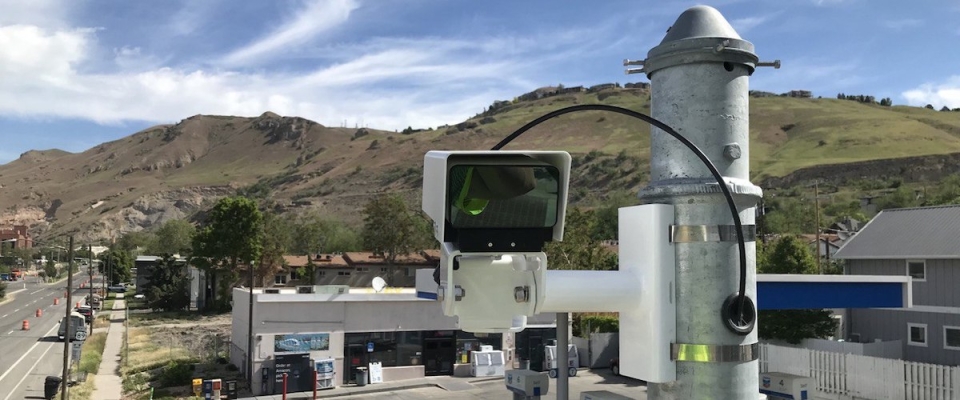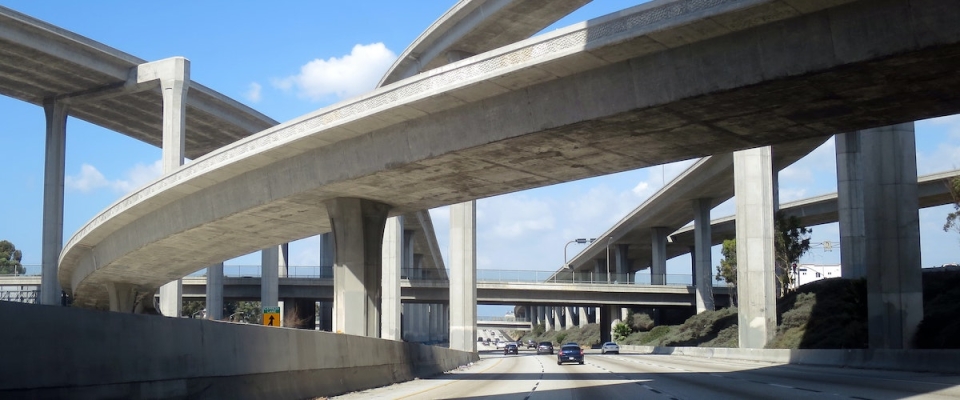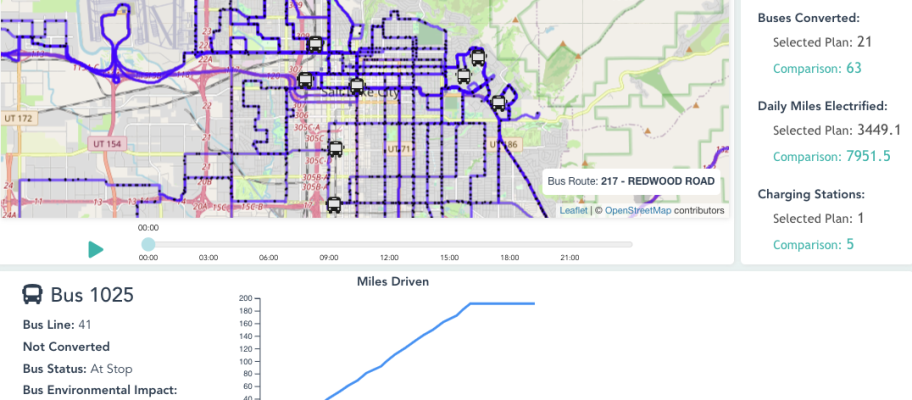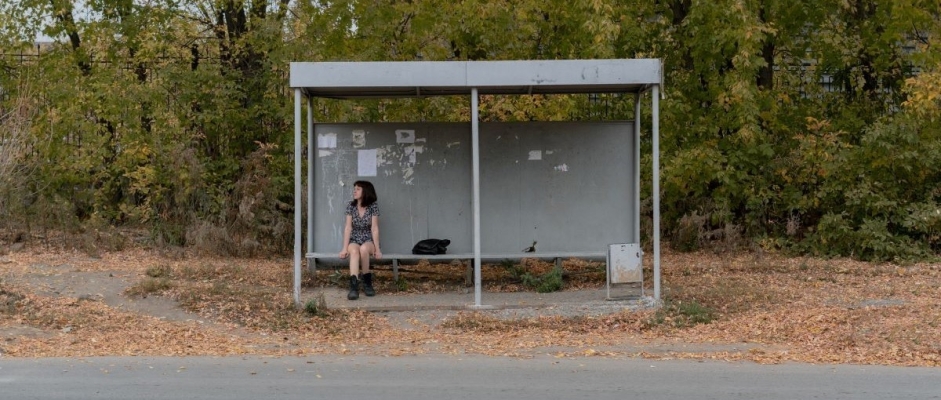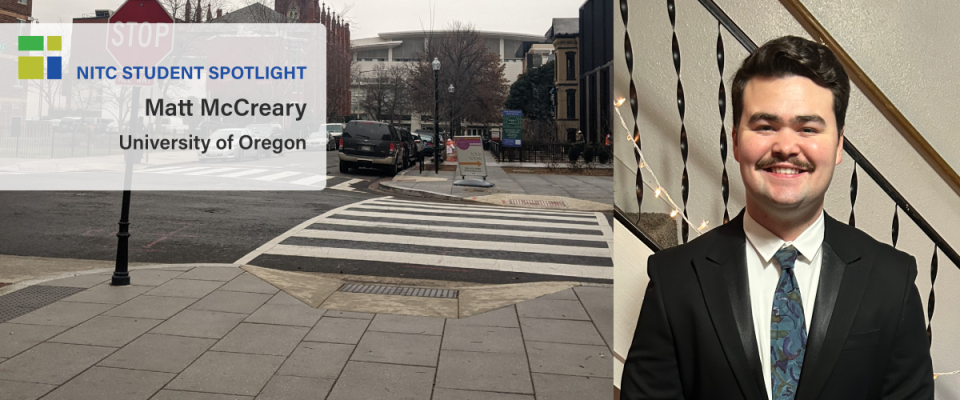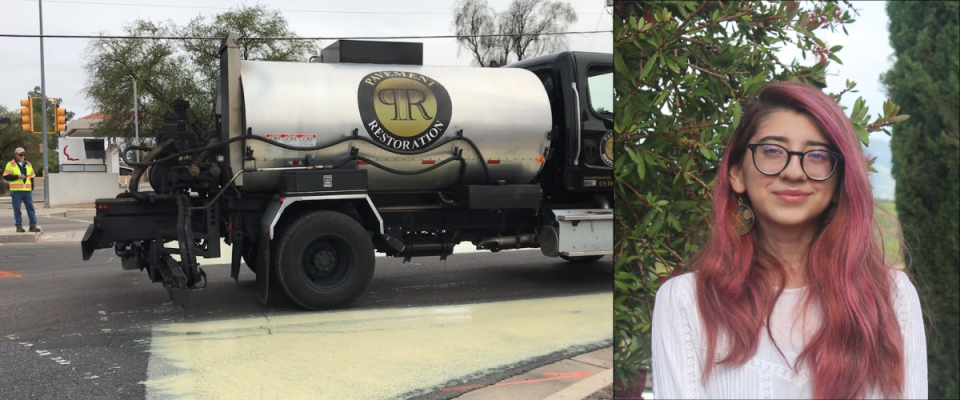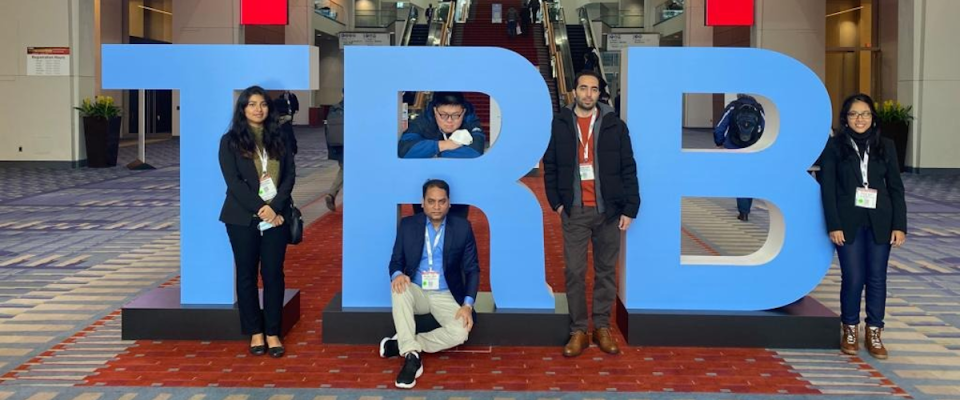Pedestrian safety is critical to improving walkability in cities. To that end, NITC researchers have developed a system for collecting pedestrian behavior data using LiDAR sensors. Tested at two intersections in Texas and soon to be tested at another in Salt Lake City, Utah, the new software created by a multi-university research team is able to reliably observe pedestrian behavior and can help reduce conflicts between pedestrians and vehicles at signalized intersections. The Utah Department of Transportation (UDOT) is already working on implementing this new system to improve data collection at intersections.
Learn more in a free webinar May 18.
The LiDAR system can especially improve multimodal travel at intersections with permissive left turns, which are indicated by a flashing yellow arrow. Previous research has shown that where a flashing yellow arrow, or FYA, is present, cars searching for a gap in traffic may not look for pedestrians. To remove the risk to people walking, some signals are programmed to turn off the FYA when a walk button is pushed. But...
Read moreThe National Institute for Transportation and Communities (NITC) is proud to introduce a new Dissertation Fellow, Adrian Cottam of the University of Arizona. Cottam's doctoral research project, Machine Learning and Big Data-Based Approaches for Quality Freeway Volumes, will focus on improving the quality of freeway volumes and expanding their spatial availability.
Read more"I was drawn to Transportation Engineering because it is a field where you can make major impacts to better your community. I found that by merging my passion for Computer Science with Transportation Engineering, I could use data to obtain more information on how local transportation could be improved through Intelligent Transportation Systems (ITS) and performance measurement. Throughout this process, I found that it was frequently a challenge obtaining high-quality data, or having access to data where you need it. This drove me to focus my dissertation on using machine learning techniques to improve data quality, and estimate traffic parameters where sensors were unavailable. My research is specifically focused on freeways, and seeks to use available data sources, such as crowdsourced data, to estimate data that isn’t always available. I am a firm believer in applied research, and hope to better my community through my research efforts. As such, I seek to develop methods that can be applied in a practical way, so...
The National Institute for Transportation and Communities (NITC) is proud to introduce a new Dissertation Fellow, Farzin Maniei of the University of Texas at Arlington, and his doctoral research project: Unsupervised Approach to Investigate Urban Traffic Crashes Based on Crash Unit, Crash Severity, and Manner of Collision.
Read more"Knowing that there has not been a day without a fatality on Texas roadway since November 7th, 2000, I have been encouraged to focus my dissertation on traffic safety analysis and traffic crash prediction models to mitigate the socioeconomic burden of traffic crashes. Typically, traffic crashes have been investigated using one or two of three major traffic crash characteristics: number of vehicles involved in the crash (crash units), manner of collision (crash type), and crash severity. Leaving out any of these characteristics may negatively affect our understanding of traffic crash patterns. My dissertation aims to investigate the pattern of traffic crashes across highways and freeways by including all three major traffic characteristics simultaneously. The study attempts to capture various groups of traffic crashes, identify their corresponding hotspots, and understand their associated contributing factors. The study will propose an advanced data-driven tool for decision-making using artificial intelligence. Also, the method provides an automated, scalable process to...
The transit industry is rapidly moving toward battery electric bus fleets because of the environmental and financial benefits they offer. As electric vehicles become more prevalent, transit agencies have several questions to consider: What is the most cost-effective and equitable way to make the transition to electric buses? How can the buses' charging needs be incorporated into the existing city power grid? In which parts of the city should electric buses be introduced first, and what impacts will all this have on transit operations? A new modeling and visualization tool can help agencies answer those questions.
With funding from a National Institute for Transportation and Communities (NITC) "Translate Research to Practice" grant, a team of University of Utah (UU) researchers led by Xiaoyue Cathy Liu and Jianli Chen have created a model—a "bi-objective optimization framework"—which takes both cost and environmental equity into consideration, helping transit agencies achieve their desired environmental and public health-related outcomes in the most cost-effective way. The flexible framework is a helpful tool for doing cost-benefit analysis on a range of transit-related objectives. The research team also created two products to help transit agencies use the model:
- A step-by-step guide to implementing the model: ...
Can Shared Mobility Reduce Transportation Disadvantage Among Survivors Of Intimate Partner Violence?
Survivors of intimate partner violence (IPV) experience transportation disadvantages, sometimes due to financial constraints caused by their abusive partners, which can keep them from accessing essential resources. Sarah Leat of the University of Memphis School of Social Work has published an article in the December 2022 Journal of Transport & Health examining how shared mobility services could help fill this transportation gap. Leat, who earned her PhD from the University of Texas at Arlington (UTA), began researching transportation challenges among IPV survivors when she was a National Institute for Transportation & Communities (NITC) Dissertation Fellow at UTA.
The Transport & Health article, "Exploring the feasibility of shared mobility services for reducing transportation disadvantage among survivors of intimate partner violence," is related to Leat's doctoral research project, "Identifying and Measuring Transportation Challenges for Survivors in Intimate Partner Violence Shelters."
Highlights from the article include:
- Sheltered survivors of intimate partner violence often lack the financial means to afford personal modes of transportation.
- Shared mobility services may be viable solutions for survivors of intimate partner violence who reside in shelters.
- ...
Matt McCreary is a planning, public policy and management student at the University of Oregon (UO). He is also a transportation safety planning intern for Better Eugene-Springfield Transportation (BEST), working on a project to make Main Street in Springfield, Oregon safer for all people and modes of transportation. In 2022, Matt interned for South Metro Area Regional Transit (SMART) in Wilsonville, Oregon as a part of the SMART Options Program Team working on community outreach.
Tell us about yourself?
My name is Matt McCreary, I will be graduating this June with a bachelor’s in Planning, Public Policy, and Management from the University of Oregon. I very much enjoy walking to get around and to see new places. I am also currently working for Better Eugene-Springfield Transportation on a safety project which I am really grateful to be a part of. I can’t wait to be a part of the future of transportation!
What (or who) has influenced your career path in transportation?
My Dad is the reason I found the planning field, he worked in parks and recreation and his experiences influenced my decision to pursue a career in planning. As I completed courses in my major, I began to be drawn more and more to transportation because of its impacts on so many aspects of our built...
Read moreWith support from a National Institute for Transportation and Communities (NITC) diversity grant, University of Arizona (UA) student Ash Avila has spent two years researching extreme heat in urban environments. An undergraduate in the Sustainable Built Environment program, Avila has supported UA researchers Ladd Keith, Nicole Iroz-Elardo and Kristina Currans on their NITC project, Assessing Cool Corridor Heat Resilience Strategies for Human-Scale Transportation. The project, which has been featured in the Washington Post and Smart Cities World, is evaluating a City of Tucson pilot application of "cool pavement" technologies, which reflect light (and therefore heat) in an effort to reduce the thermal load of roads. It is part of a larger effort by UA researchers looking at measuring and evaluating personal heat exposure.
Next week, Ash will present at her second Transportation Research Board (TRB) annual meeting. Alongside Currans, Iroz-Elardo...
Read moreThe 102nd annual meeting of the Transportation Research Board (TRB) will be held January 8–12, 2023 in Washington, D.C. Supported by funding from the U.S. Department of Transportation, research from the National Institute for Transportation and Communities (NITC) will be featured at this annual gathering. The spotlight theme for the 2023 meeting is Rejuvenation Out of Disruption: Envisioning a Transportation System for a Dynamic Future.
Below are a few highlights of research being presented by transportation experts from our participating NITC-funded campuses: Portland State University (PSU), University of Oregon (UO), University of Utah (UU), University of Arizona (UA), and University of Texas at Arlington (UTA). Check out our full NITC guide for all of the sessions:
VIEW THE ONLINE GUIDE TO NITC AT TRB 2023
*Due to the evolving status of speaker attendance and TRB programming for next week, please check your TRB schedule for the most current information in the event of changes.*
NITC Research Highlights at TRB 2023
MULTI-UNIVERSITY PROJECTS
The Outstanding Student of the Year award is presented during the Council of University Transportation Centers (CUTC) banquet at each annual meeting of the Transportation Research Board, where the U.S. Department of Transportation honors an outstanding graduate student from each UTC. Sadie Mae Palmatier will be presented with the award for NITC at this year's CUTC award ceremony. See past NITC Students of the Year.
NITC OUTSTANDING STUDENT OF THE YEAR
Sadie Mae Palmatier, University of Oregon
Connect with Sadie Mae on Linkedin
Twelve students attending partner universities of the National Institute for Transportation and Communities (NITC) are receiving Eisenhower Fellowships presented by the U.S. Department of Transportation at this year's annual meeting of the Transportation Research Board (TRB). Meet the NITC Eisenhower Fellows:

